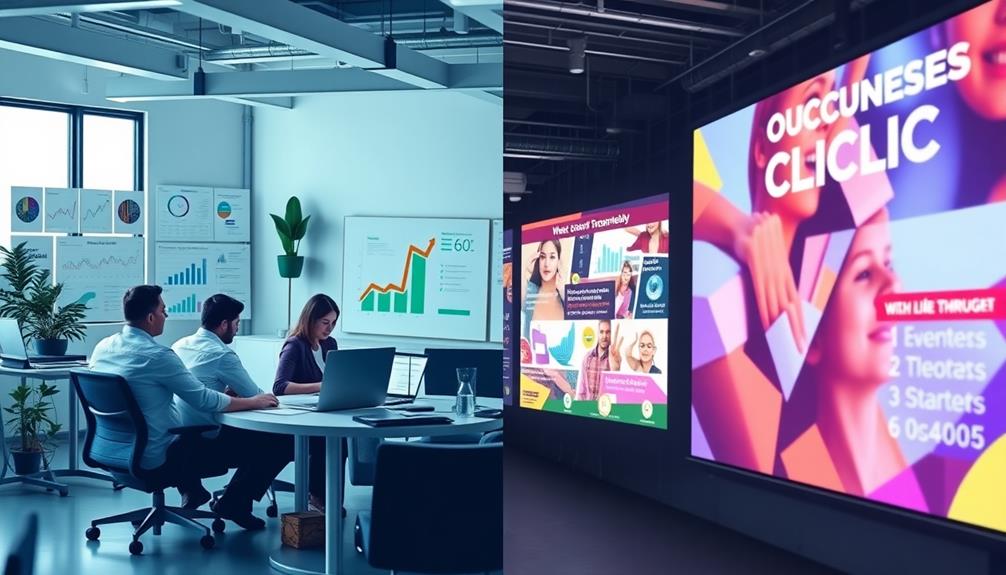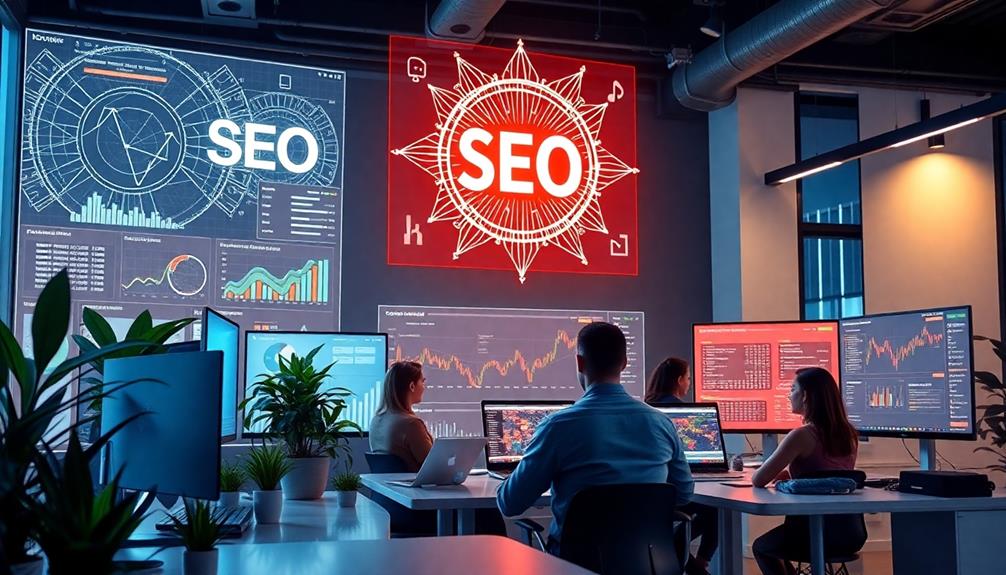When deciding between SEO and PPC, it really depends on your business goals. SEO focuses on long-term visibility and can provide a sustainable influx of organic traffic without ongoing costs per click. On the other hand, PPC delivers immediate results and lets you target specific audiences, but it requires continuous investment. If you need quick visibility and leads, PPC might suit you better. Conversely, if you want to build long-term credibility and lower costs over time, SEO's the way to go. Understanding the nuances of each strategy can help you refine your marketing approach effectively.
Key Takeaways
- SEO offers long-term traffic growth without ongoing costs, while PPC provides immediate visibility and quick results.
- SEO builds brand credibility and trust, whereas PPC allows for precise audience targeting and budget flexibility.
- SEO requires time and resources for results, but PPC can lead to significant costs if not managed effectively.
- Combining SEO and PPC strategies can maximize visibility, enhance brand recognition, and improve overall marketing effectiveness.
- A/B testing and performance analysis are crucial for optimizing both SEO and PPC efforts for better conversion rates.
Understanding SEO and PPC
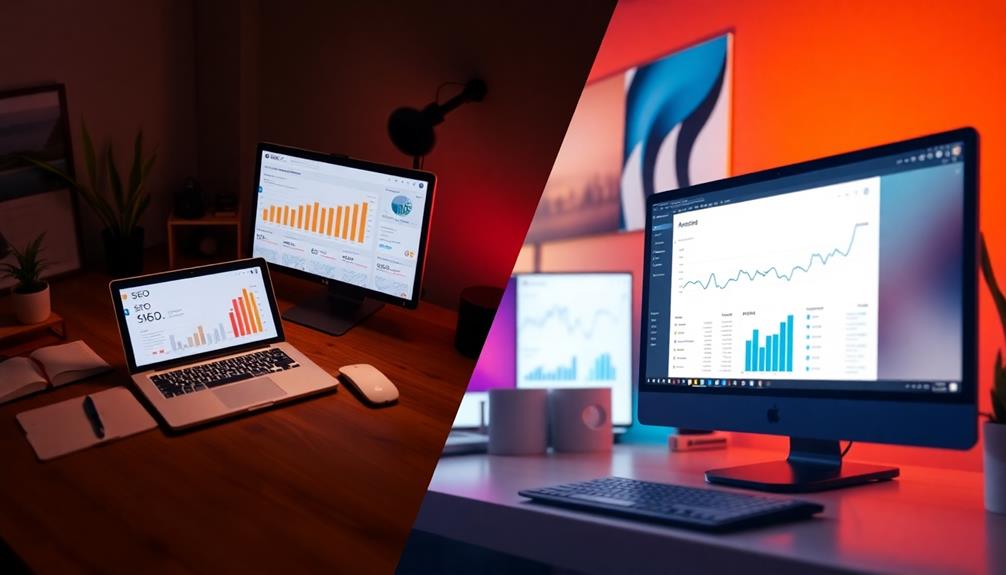
When maneuvering the digital marketing landscape, understanding SEO and PPC is essential for your business. SEO, or search engine optimization, focuses on boosting your website's organic visibility in search engine results pages (SERPs). It involves strategies like keyword research, on-page optimization, and quality backlink building. The goal is to achieve long-term traffic growth without incurring ongoing costs per click.
Additionally, leveraging insights from startup stories can help identify effective SEO practices that have worked for successful businesses.
On the other hand, PPC, or pay-per-click, is an online advertising model that lets you pay for each click on your ads, which appear prominently at the top of SERPs. This approach allows for immediate results, generating traffic as soon as your campaigns are launched. It's particularly effective for time-sensitive promotions and targeting specific demographics.
While SEO takes time to yield significant traffic increases, the costs associated with it are largely upfront, leading to lasting benefits. In contrast, PPC incurs ongoing expenses, which can accumulate quickly in competitive markets.
Benefits of SEO

When you invest in SEO, you're setting yourself up for long-term traffic growth that pays off over time.
It's a cost-effective strategy that not only boosts your visibility but also enhances your brand's credibility among users who trust organic results over paid ads.
Additionally, incorporating insights from AI in Business can help you refine your approach to SEO by analyzing customer sentiment and preferences.
Long-Term Traffic Growth
SEO offers a powerful advantage in long-term traffic growth, as it generates consistent organic visitors without the need for continuous investment like PPC campaigns. By focusing on SEO, you can build a solid foundation of organic traffic that keeps coming, even after your initial efforts.
Additionally, implementing a solid IRA Investment Strategy can enhance your overall business visibility and online presence. With 70-80% of users ignoring paid ads, prioritizing SEO enhances your website visibility in search engine results.
Investing in SEO strategies like quality content creation and backlink building can take time—typically 6-12 months to see substantial results. However, once established, this traffic can yield ongoing benefits that far outlast the fleeting results of PPC campaigns.
In fact, businesses often achieve an impressive ROI of 500% or more through effective SEO, with some industries enjoying returns as high as 1,389% over three years.
Moreover, around 35.18% of clicks from Google searches go to organic listings. This statistic emphasizes the importance of SEO for anyone looking to enhance their marketing strategies.
Cost-Effective Strategy
Harnessing the benefits of SEO leads to a cost-effective strategy that can greatly boost your business's bottom line.
Unlike PPC, where you're continually paying for each click, SEO focuses on sustainable traffic generation without ongoing fees. This approach allows you to enjoy ongoing benefits and enhanced brand visibility over the long term.
Additionally, implementing effective creating a personal budget techniques can help allocate resources efficiently for your SEO efforts, ensuring you get the most out of your investment.
Here are three reasons why SEO is a cost-effective choice for your business:
- High Return on Investment: SEO efforts can yield an ROI between 500% to 1,300%, making it a financially advantageous long-term strategy.
- Increased Organic Traffic: Organic search results typically have higher click-through rates compared to paid ads, attracting more relevant visitors to your site.
- Sustained Traffic Flow: Once your website achieves higher rankings, it can maintain visibility and continue to generate traffic without the need for constant financial investment.
Enhanced Brand Credibility
A strong online presence greatly boosts your brand's credibility, as consumers increasingly trust organic search results over paid ads. In fact, 70-80% of users ignore paid listings entirely, which means investing in SEO can profoundly enhance your brand's authority in your industry. High rankings in organic search results not only showcase your expertise but also foster trust among potential customers.
Additionally, businesses that prioritize creating a retirement savings plan can demonstrate financial responsibility, further enhancing their credibility with clients. Brands that prioritize SEO enjoy long-term visibility; 61% of marketers recognize improving SEO as their top inbound marketing priority. This commitment pays off, as organic listings attract more clicks—studies indicate that the top position can garner up to 30% of total clicks. This reinforces your brand credibility, making it a go-to choice for users.
Moreover, effective SEO strategies enhance user experience by optimizing your website's content and structure. A well-organized site keeps visitors engaged, improving their perception of your brand. When users find what they need quickly and easily, their trust in your business increases.
Ultimately, investing in SEO not only boosts your visibility but also solidifies your brand's reputation in a competitive market.
Drawbacks of SEO

When diving into search engine optimization, you'll quickly discover several drawbacks that can complicate your efforts.
First, SEO takes time. In fact, only 22% of pages in the top 10 search results were published within the past year, meaning that new content may not rank effectively for quite a while. This slow burn contrasts with other strategies, such as affiliate marketing insights, which can generate revenue more quickly through commissions.
Second, the competitive landscape for popular keywords can be intimidating. Established players often dominate search results, making it tough for beginners to achieve visibility.
Lastly, it's a resource-intensive process that demands extensive effort. You need to create quality content and optimize it continuously while adapting to ongoing algorithm changes. This requires staying informed about various ranking factors that can shift without warning.
In summary, here are three key drawbacks of SEO:
- Time-Intensive: Results can take months to materialize.
- High Competition: Popular keywords are often hard to rank for due to established competitors.
- Technical Complexity: Beginners may struggle with technical aspects, making the learning curve steep.
Understanding these challenges will help you make informed decisions about your marketing strategy.
Benefits of PPC
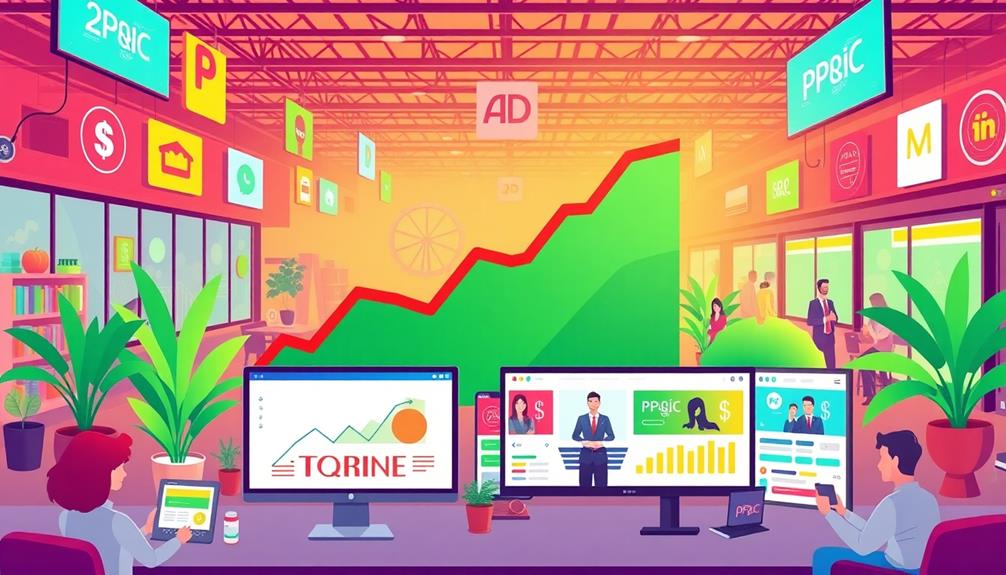
When you invest in PPC, you get immediate traffic right after launching your campaign, which is perfect for promotions or product launches.
This approach allows businesses to quickly gauge market response and adjust their strategies accordingly, enhancing overall effectiveness.
You also gain the flexibility to control your budget, ensuring you only spend what you can afford while targeting the right audience.
This level of precision means your ads reach those most likely to convert, maximizing your return on investment.
For further insights on how to effectively manage your resources, consider actionable tips and strategies.
Immediate Traffic Generation
While businesses often seek long-term strategies for growth, PPC campaigns offer an immediate boost in traffic that can be hard to resist. With the ability to generate immediate traffic generation, you can see results often within hours of launching your ads.
Additionally, leveraging advanced technologies such as AI enhances threat detection can further optimize your PPC campaigns by analyzing data patterns for improved targeting.
Here's why PPC is a powerful tool for quick visibility:
- Target Specific Keywords: You can tailor your campaigns to focus on specific keywords that your audience is searching for, ensuring that your ads reach those most likely to convert.
- Real-Time Performance Tracking: Track your campaign performance in real-time, enabling you to make adjustments that enhance click-through rates and conversions on the spot.
- A/B Testing: Use A/B testing to refine your ad copy and landing pages, leading to higher engagement and better conversion rates almost immediately.
Precise Audience Targeting
One of the standout benefits of PPC is its ability to precisely target your audience, ensuring your ads reach the right people at the right time.
With PPC, you can segment your audience based on demographics, interests, and online behavior, making it easier to connect with the most relevant potential customers. This level of precise audience targeting greatly boosts your chances of higher conversion rates, especially when you consider the importance of understanding Canadian business services to tailor your approach effectively.
Utilizing geo-targeting features allows you to display ads to users in specific locations, enhancing your appeal to local customers.
You can also set custom targeting parameters, such as device type and time of day, optimizing ad visibility for user preferences.
Moreover, PPC platforms offer robust retargeting options that let you re-engage users who've previously interacted with your website or ads.
This keeps your brand top-of-mind, increasing the likelihood of conversion.
Budget Flexibility Options
PPC not only excels in precise audience targeting but also provides advertisers with remarkable budget flexibility options. With PPC campaigns, you gain exceptional budget control, allowing you to set daily limits that align with your financial goals. This guarantees you only spend what you can afford while still achieving visibility.
Additionally, just as managing credit card debt is vital for financial stability, effective PPC management can lead to ideal allocation of marketing resources, enhancing overall performance in a competitive landscape effective marketing strategies.
Here are three key budget flexibility options that PPC offers:
- Real-time Performance Adjustments: You can modify bids based on campaign performance, reallocating funds to high-performing ads and keywords for ideal results.
- Responsive Budgeting: The ability to pause or stop campaigns anytime helps you adapt to market changes or budget constraints without long-term commitments.
- A/B Testing: Experiment with different ad copies and landing pages to identify which strategies yield the highest return on investment, optimizing your spending effectively.
PPC's immediate results mean you can quickly see traffic and conversions, allowing for responsive budgeting grounded in real-time performance analytics. This level of flexibility guarantees you remain agile and competitive in a rapidly changing marketplace.
Drawbacks of PPC

In today's fast-paced digital landscape, the drawbacks of PPC can quickly become apparent. One major issue is the high costs per click, especially in competitive sectors where you might face rates as high as $40 for car insurance ads. This can lead to significant expenses without delivering substantial traffic or leads if not managed effectively.
Moreover, when your budget runs out, the benefits of your PPC campaigns disappear immediately. Unlike SEO, which builds long-term visibility, PPC offers no residual value from past investments. Click fraud also poses a serious threat, inflating your costs and wasting your budget on invalid clicks.
As your ads run over time, you might encounter ad fatigue, which can decrease click-through rates as your audience becomes desensitized to repetitive ads.
To counter these issues, continuous management of your PPC campaigns is essential, requiring dedicated resources and expertise. If you don't invest the necessary time and effort, you risk wasting your ad spend without achieving your desired results.
Being aware of these drawbacks can help you make informed decisions about your marketing strategy.
Combining SEO and PPC

How can combining SEO and PPC elevate your online marketing efforts? By leveraging both strategies, you can greatly enhance your online visibility. While PPC campaigns provide immediate exposure, SEO builds a long-term presence, creating a balanced approach that maximizes your reach.
Here are three key benefits of combining SEO and PPC:
- Data-Driven Insights: PPC campaigns offer valuable data on keyword performance and audience behavior. You can use this information to refine your SEO strategies, making them more effective.
- Targeted Demographics: Combining SEO and PPC allows you to fill gaps in your online presence. PPC can target specific demographics that SEO might miss, ensuring you reach a broader audience.
- Improved Brand Recognition: Consistent messaging across both channels enhances consumer trust. When potential customers see your brand in both organic and paid results, it reinforces your credibility.
Furthermore, A/B testing in PPC can inform your SEO landing pages, helping you identify effective messaging and design that drives conversions.
Ultimately, integrating these approaches not only boosts visibility but also fosters a stronger connection with your audience.
Key Strategies for Optimization
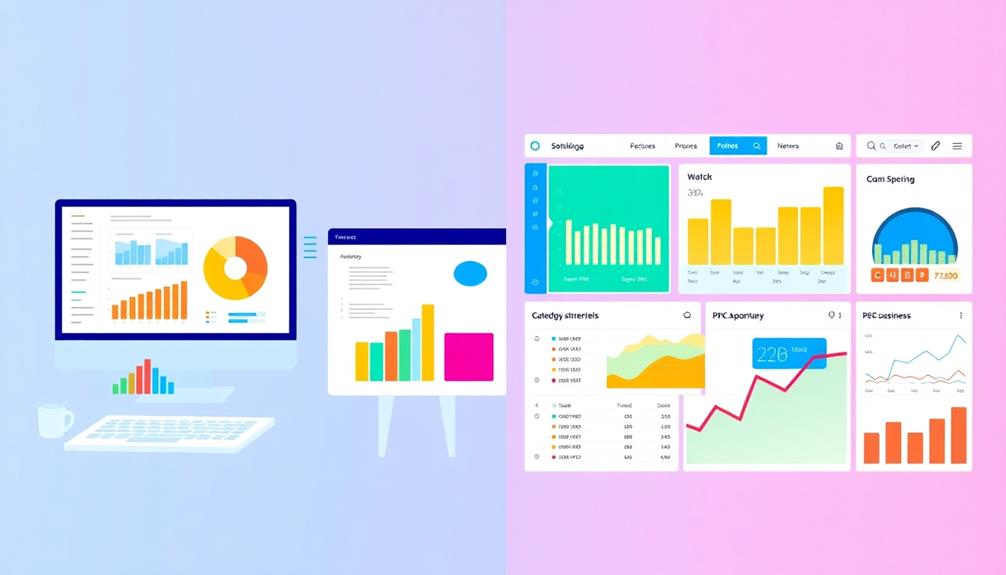
A successful online marketing strategy hinges on effective optimization techniques for both SEO and PPC. Start with effective keyword research, utilizing tools like Google Keyword Planner to identify high-traffic terms that resonate with your target audience searches. This lays a strong foundation for your campaigns.
Next, focus on on-page SEO optimization. Improve your meta tags, header tags, and content quality to enhance organic rankings and user engagement, ultimately boosting visibility.
Regularly conduct performance analysis to track the effectiveness of your SEO and PPC efforts. This data-driven approach allows you to make necessary adjustments and optimizations.
In PPC, implement A/B testing landing pages to refine your messaging and design. By determining what resonates best with your audience, you can achieve higher conversion rates, which also informs your on-page SEO strategies.
Importance of Landing Pages
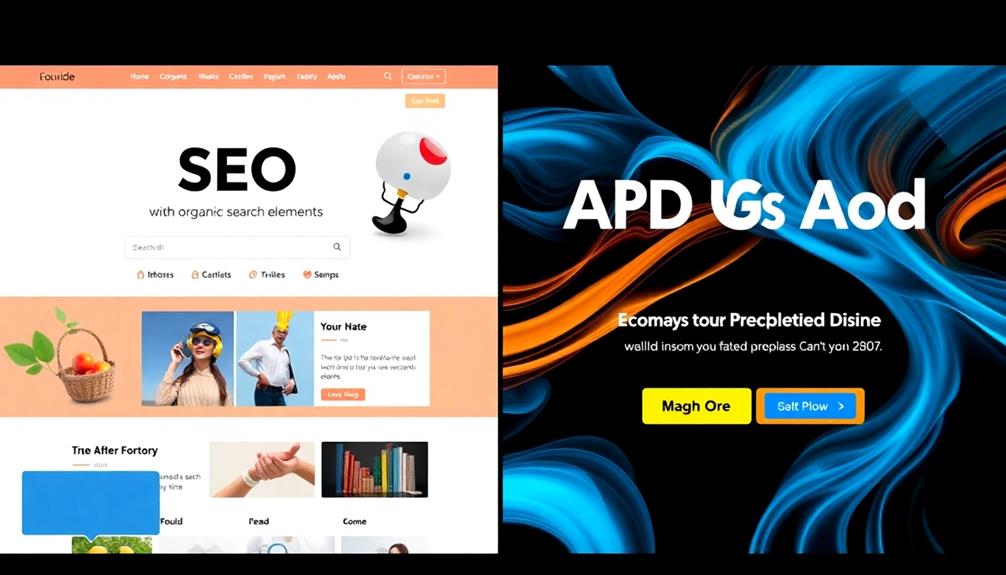
Landing pages play an essential role in converting visitors into leads or customers, directly impacting your marketing success. When designed effectively, landing pages can greatly improve conversion rates, especially when they're optimized for your targeted campaigns.
Here are three key reasons why landing pages matter:
- Clear Calls-to-Action (CTAs): Effective CTAs guide user behavior and are vital for achieving desired outcomes. In fact, strong CTAs can increase conversion likelihood by 121%.
- Integration with PPC Campaigns: When you integrate landing pages with your PPC campaigns, you maximize advertising ROI. About 68% of marketers believe landing page optimization is vital for successful PPC performance.
- Mobile Optimization: With 53% of mobile users abandoning sites that take longer than three seconds to load, fast and responsive landing pages are a must. This emphasizes the importance of continuous optimization to enhance user experience.
Cost Analysis of SEO vs. PPC

When considering costs, you'll see that SEO often requires a larger upfront commitment but pays off in the long run, while PPC offers immediate results at a continuous price.
Your budget flexibility matters too; with PPC, you control spending daily, but you risk running out of funds quickly.
In contrast, once you invest in SEO, you can enjoy ongoing traffic without the constant financial drain.
Long-term vs. Short-term Costs
Understanding the cost dynamics between SEO and PPC is essential for any business aiming to maximize its marketing budget. When analyzing long-term versus short-term costs, you'll find that each strategy has its unique financial implications.
1. Long-term Investment: SEO involves an initial investment in content creation and optimization, but once established, it can generate organic traffic for years without ongoing expenses.
Businesses can expect an ROI from SEO of at least 500% over three years.
2. Short-term Costs: PPC advertising, while offering immediate traffic, requires continuous payments for each click.
In competitive markets, PPC costs can skyrocket, with some keywords reaching $40 per click.
3. Sustainability vs. Instant Gratification: SEO results might take 4-6 weeks to materialize for low-competition keywords, but they provide lasting benefits.
In contrast, once your PPC budget is depleted, so too is your visibility.
Ultimately, for sustainable growth, investing in SEO is often more cost-effective compared to the ongoing expenditures associated with PPC, especially in high keyword competition markets.
Budget Flexibility and Control
Budget flexibility and control play an essential role in deciding between SEO and PPC for your marketing strategy.
With SEO, you typically face an initial investment in content and optimization, but once established, it incurs no ongoing costs per click. This approach can lead to an impressive ROI of 500% to 1,300%, making it more cost-effective in the long run.
In contrast, PPC requires continuous spending for each click, especially in competitive sectors where costs can skyrocket to $40 per click for high-demand keywords.
PPC offers you the ability to set daily or monthly spending limits, which provides a level of budget control. However, this flexibility comes at the cost of ongoing financial investment, often yielding a lower ROI of around 200%.
Balancing these strategies can maximize your budget flexibility. By leveraging SEO for sustainable traffic gains and using PPC for immediate visibility in urgent campaigns, you can allocate resources where they're most needed.
Ultimately, understanding the trade-offs between SEO and PPC will help you maintain control over your budget while optimizing your marketing efforts.
Making the Right Choice
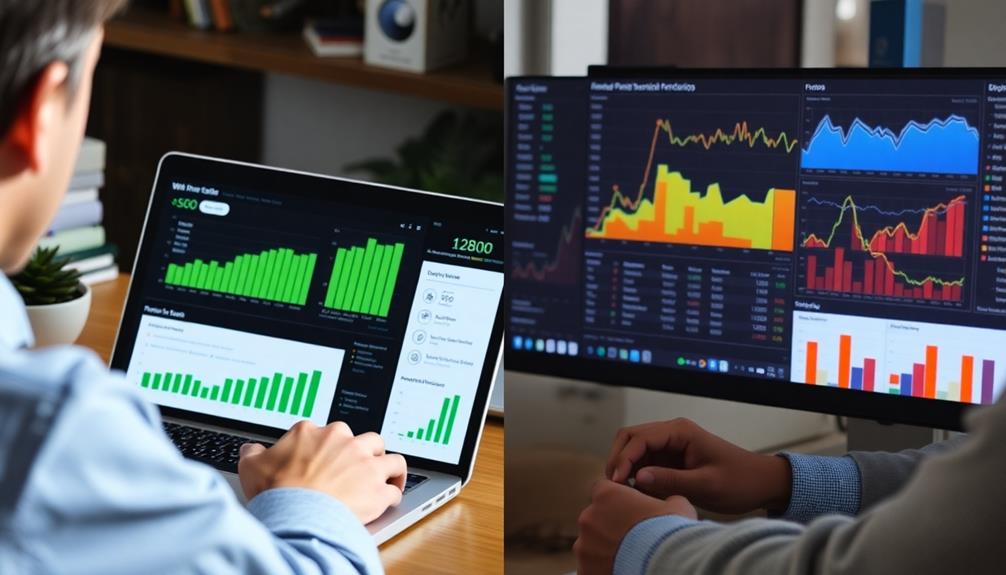
Choosing between SEO and PPC can feel overwhelming, but it ultimately hinges on your business goals and timeline. Here are three key considerations to help you make the right choice:
- Marketing Goals: If you're looking for immediate visibility and rapid customer acquisition, PPC might be your best bet. However, if your focus is on building organic traffic and long-term credibility, SEO is the way to go.
- Timeframe: SEO is a long-term strategy that typically requires 6-12 months to yield significant results. In contrast, PPC campaigns can drive traffic and leads as soon as they're launched, making it ideal for time-sensitive offers.
- Target Audience: With PPC, you can target your audience based on demographics and behavior, ensuring your ads reach the right people. SEO, on the other hand, organically attracts visitors over time, which can lead to sustained visibility in search engine results pages.
Ultimately, integrating both strategies can optimize your marketing efforts, balancing immediate results with long-term growth.
Consider your specific needs and choose accordingly to maximize your ROI.
Frequently Asked Questions
Is PPC Better Than SEO in 2024?
In 2024, you'll find PPC offers quick visibility and immediate results, perfect for urgent campaigns. However, consider SEO for sustainable growth and long-term ROI, as it builds trust and organic reach over time.
What Is the ROI of SEO Vs PPC?
When you compare the ROI of SEO and PPC, you'll find SEO can yield 500% to 1,300% over three years, while PPC usually offers around 200%. Consider your long-term goals when choosing.
Do 70 of Marketers See SEO as More Effective Than PPC?
As they say, "The proof is in the pudding." Yes, 70% of marketers do see SEO as more effective than PPC, valuing its long-term benefits and organic traffic over the temporary gains from paid ads.
Which Is Better SEO or Facebook Ads?
When deciding between SEO and Facebook Ads, consider your goals. If you need immediate results and targeted engagement, Facebook Ads might suit you. However, if you're looking for sustainable long-term visibility, SEO's the way to go.
Conclusion
In the battle of SEO vs. PPC, it often boils down to your business goals. Did you know that 70% of clicks go to organic results? This shows the power of SEO, but don't underestimate PPC's ability to deliver immediate traffic. Ultimately, the right choice depends on your budget, timeline, and desired results. By understanding both strategies and how they fit into your overall plan, you can drive success for your business effectively.

